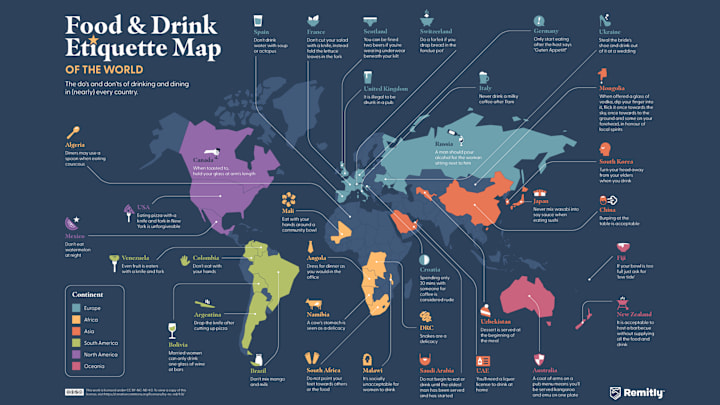Think of dining etiquette, and the first thing that comes to mind is probably something about keeping your elbows off the tabletop, or maybe not chewing with your mouth open.
But if you were to take a look at dining traditions all around the globe, you’d soon find that different countries and cultures have amassed all manner of rules and recommendations when it comes to taking your seat at the dinner table. Now, a fascinating new analysis has compiled some of the world’s most interesting food and drink etiquette—from strange local laws and dining regulations to delicious dishes and traditions passed down over generations.
Finance website Remitly scoured Google and Reddit as well as guide books for local food and drink etiquette from a total of 180 countries across the world, collating all of their results in a global analysis complete with a world map. The rules and advice encompass everything from tea and coffee traditions to menus and cutlery, unusual diets and dishes, and even drunkenness.

Breaking the data down by continent showed some intriguing regional trends around the world. In Europe (the only region for which an additional map was created), there are a host of traditions and etiquette expectations surrounding the drinking and serving of alcohol. In the Czech Republic, it was found that placing a coaster over your beverage means that you don’t want any more to drink, keeping a keen host from topping up your glass after you’ve had enough. In the United Kingdom, meanwhile, it’s technically illegal to be drunk in a pub (thanks to Section 12 of the 1872 Licensing Act), while anyone found wearing underwear under their kilt in Scotland might be fined two beers.

Not all of Europe was quite so concerned with alcoholic drinks. In Spain, it’s apparently considered best practice not to drink water with soup (or with octopus, for that matter), while drinking milky coffee after 11 a.m. in Italy is frowned upon too.
Liquor did crop up in many other country’s rulebooks around the world, however: Toasts are typically held at arm’s length in Canada; in Peru, sharing a beer with friends means sharing it from a single glass; married women can consume just a single glass of wine in a bar in Bolivia; and in Malawi, it’s deemed socially unacceptable for a woman to drink, period.
Elsewhere in Africa, many local traditions and etiquette rules involved not what was consumed, but how it was served and consumed. Eating and drinking simultaneously is disapproved of in Rwanda, for example, while diners in Mauritania use utensils only when they’re partaking in Western food. In Libya, food should only be consumed after dipping three digits into perfumed water.
Religious practices informed many of Asia’s traditions: Eating, drinking, and even smoking are illegal during periods of fasting in Brunei, and some people in the Philippines avoid alcohol until an offering to the spirits has been made (typically by pouring some of the drink onto the ground). Mongolians avoid all drinks on the first of each month. In Nepal, it’s considered rude to eat around others without offering them anything, and in Turkmenistan, eating while walking is seen as impolite. South Koreans are expected turn their heads away from elders when they take a drink.
Across the Pacific in South America, there are no regular mealtimes at all in Suriname, allowing diners the freedom to eat whenever they wish, and in Bolivia, food should be placed on the table next to guests, rather than given to them.
Some countries were found to follow the complete opposite rules and traditions to others, showing just how different global cultures can be. While it is considered a sign of respect to one’s host to eat with your hands in the Central African Republic, eating any food with your hands is apparently considered rude in Colombia (and in Venezuela, even fruit is typically eaten with a knife and fork). And in the words of the analysis’s authors, eating a slice of pizza with a knife and fork in New York is “unforgiveable.”
In addition to etiquette rules, some of the analysis focused on local delicacies, which included a cow’s stomach (Namibia), a jellied “souse” loaf made with pig’s ears, feet, tongues, and tails (Barbados), cooked snakes (the Democratic Republic of the Congo), and a bush fruit known as atanga, which is boiled and then layered on baguettes (Gabon). And on the subject of bread, tradition dictates that anyone who drops a piece of bread into the melted cheese while enjoying a traditional fondue in Switzerland has to pay a forfeit.
Many of the findings of the analysis might seem strange to those of us who don’t live in these countries; the researchers involved in the work were aiming to help anyone who is planning to move to or travel in an unfamiliar country by unearthing some of the rules and etiquette expectations they might well encounter while dining there. Ultimately, having some idea of what to expect when you get to your destination—no matter how bizarre it might sound—will give you a welcome head start when it comes to fitting in with your hosts at dinner time.
Discover More Fascinating Maps:
